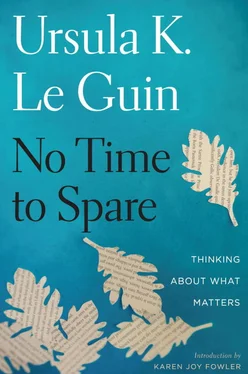Insofar as the feminism of the 1970s played on fear, exalting the independence and interdependence of women, it was playing with fire. We cried “Sisterhood is powerful!”—and they believed us. Terrified misogynists of both sexes were howling that the house was burning down before most feminists found out where the matches were.
The nature of sisterhood is so utterly different from the power of brotherhood that it’s hard to predict how it might change society. In any case, we’ve seen only a glimpse of what its effects might be.
The great ancient male institutions have been increasingly infiltrated by women for the last two centuries, and this is a very great change. But when women manage to join the institutions that excluded them, they mostly end up being co-opted by them, serving male ends, enforcing male values.
Which is why I have a problem with women in combat in the armed services, and why I watch the rise of women in the “great” universities and the corporations—even the government—with an anxious eye.
Can women operate as women in a male institution without becoming imitation men?
If so, will they change the institution so radically that the men are likely to label it second-class, lower the pay, and abandon it? This has happened to some extent in several fields, such as the practice of teaching and medicine, increasingly in the hands of women. But the management of those fields, the power and the definition of their aims, still belongs to men. The question remains open.
As I look back on the feminism of the late twentieth century, I see it as typical of feminine solidarity—all Indians, no chiefs. It was an attempt to create an unhierarchical, inclusive, flexible, collaborative, unstructured, ad hoc body of people to bring the genders together in a better balance.
Women who want to work toward that end need, I think, to recognize and respect their own elusive, invaluable, indestructible kind of solidarity—as do men. And they need to recognize both the great value of male solidarity and the inferiority of gender solidarity to human solidarity—as do men.
I think feminism continues and will continue to exist wherever women work in their own way with one another and with men, and wherever women and men go on questioning male definitions of value, refusing gender exclusivity, affirming interdependence, distrusting aggression, seeking freedom always.
November 2010
THE ROMAN CATHOLIC bishops of the United States are holding a conference on exorcism in Baltimore today and tomorrow. Many bishops and sixty priests are there to learn the symptoms of demonic possession—you may be possessed if you exhibit unusual strength, talk in a language you don’t know, or react violently to anything holy—and the rites of exorcism, which include sprinkling holy water on you, laying hands on you, recitations, invocations, and blowing in your face.
The church updated the rite in 1999, advising that “all must be done to avoid the perception that exorcism is magic or superstition.” This seems rather like issuing directions for driving a car while cautioning that all must be done to avoid the perception that a moving vehicle is being guided.
I’d advise weightlifters and people learning a foreign language to avoid Baltimore this weekend. I don’t know how to advise people who react violently to anything holy. I don’t know who they are, because I don’t know what kind of violent reaction is meant, and because “what is holy” depends entirely on your perception of sacredness. If I am shaken by unutterably strong emotion when I watch a pair of eagles dance with each other on the wind, or when I hear the first notes of the theme of the last movement of the Ninth Symphony, am I possessed by a demon? I don’t know, but I’m staying away from Baltimore.
I think the people who should hurry there are the four male Catholic judges of the United States Supreme Court, all of whom are adherents of the policies of Pope Ratzinger and members of the ultra-reactionary Catholic group Opus Dei. Exorcism lessons should enrich their repertory no end. The fifth Roman Catholic on the Supreme Court is a woman, and thereby excluded from doing the “work of God.”
February 2011
THE UNITED STATES went to war with Germany and Japan when I was a kid of eleven. One of the things I remember is how—overnight, it seemed to me—the streets of Berkeley filled up with uniforms. All during the war, men in civvies were in the minority downtown. But the uniforms didn’t bring uniformity into the city. If anything, they were an improvement on the drab, same-old clothing of the end of the Great Depression.
The army and army air force wore khaki in various shades of brown, greenish, and tan: handsome jackets, creased pants, shined black shoes, all very trim. But never quite a match for the navy uniforms, the gobs in their white tunics and pants and little round white hats in summer, and in winter, blue wool tunics with a sailor collar and pants with a thirteen-button, square flap fly, I kid you not. Cute little round butts looked terrific in that uniform. And the officers in their crisp white or navy blue, gold buttons, gold braid, were a breed apart, sharp as tacks. There were no Marine bases near Berkeley that I know of; anyway we didn’t see Marines around much, but they looked quite grand in the newsreels.
My brother Clif’s ship was commissioned in San Francisco Harbor and we went to the ceremony: a fine show, formal, traditional, embellished by those dandy dress uniforms. The men looked terrific lined up there on the deck, all blue and white and gold in the sun. What boy wouldn’t want to look like that, and be seen looking like that by everybody?
A uniform, ever since the eighteenth century, when they first really started inventing them, has been known as a powerful aid to recruitment.
I can’t say that that was true for the uniforms women got handed in WWII. They imitated the men’s, of course, with skirts instead of pants, but were poorly designed, the taut, snappy look becoming tight and stiff on women; even granted the severe rationing of cloth, the uniforms were unnecessarily skimpy, prim, and awkward. I certainly wouldn’t have joined the WAVES or the WAC for the uniform, only in spite of it. Fortunately for the WAVES, the WAC, and me, I was fifteen when the war ended.
During the next several American wars, the whole concept of the uniform evolved away from good fit and good looks toward a kind of aggressively practical informality, or sloppiness, or slobbishness. By now our soldiers are mostly seen in shapeless, muddy-looking spotted pajamas.
This uniform may be useful and comfortable in the jungles of Vietnam or the deserts of Afghanistan. But do men need camouflage when flying from Reno to Cincinnati, or combat boots on Fifth Avenue? I guess soldiers still have dress uniforms—I know the Marines do, they seem to put them on way more often than the other services, maybe because they get so many photo ops in D.C.—but I can’t remember when I last saw an army private on the street looking sharp.
I know that for many boys and men, camo has taken on the glamour that a handsome uniform once had. Grotesque as it appears to me, it looks manly and fine to them. So I guess the uniform still serves as an aid to recruitment, luring the boy who wants to wear it, look like that, be that soldier. And I don’t doubt that young men wear it with pride.
But I wonder very much about the effect of the camo-pajama uniform on most civilians. I find it not only degrading but disturbing that we dress up our soldiers in clothes suitable to jail or the loony bin, setting them apart not by looking good, looking sharp, but by looking like clowns from a broken-down circus.
Читать дальше












